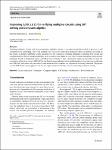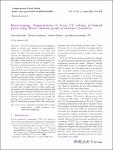Search
Author
- Jorgensen, Ed (3)
- McFadyen, Ron (3)
- Nora, El-Rashidy (3)
- Christian, Homeyer (2)
- next >
Subject
- programming (10)
- Open Access (8)
- Java (7)
- Programming (7)
- next >
Date issued
- 2020 - 2025 (293)
- 2010 - 2019 (39)
- 2000 - 2009 (2)
- 1999 - 1999 (1)
Has File(s)
- true (335)
Search Results
Infant cry is one of the first distinctive and informative life signals observed after birth. Neonatologists and automatic assistive systems can analyse infant cry to early-detect pathologies. These analyses extensively use reference expert-curated databases containing annotated infant-cry audio samples. However, these databases are not publicly accessible because of their sensitive data. Moreover, the recorded data can under-represent specific phenomena or the operational conditions required by other medical teams. Additionally, building these databases requires significant investments that few hospitals can afford. This paper describes an open-source workflow for infant-cry detection, which identifies audio segments containing high-quality infant-cry samples with no other overlapp... |
Multi-output Gaussian processes (MOGPs) can help to improve predictive performance for some output variables, by leveraging the correlation with other output variables. In this paper, our main motivation is to use multiple-output Gaussian processes to exploit correlations between outputs where each output is a multi-class classification problem. MOGPs have been mostly used for multi-output regression. There are some existing works that use MOGPs for other types of outputs, e.g., multi-output binary classification. |
Verifying arithmetic circuits and most prominently multiplier circuits is an important problem which in practice is still considered to be challenging. One of the currently most successful verification techniques relies on algebraic reasoning. In this article, we present AMULET2, a fully automatic tool for verification of integer multipliers combining SAT solving and computer algebra. Our tool models multipliers given as and-inverter graphs as a set of polynomials and applies preprocessing techniques based on elimination theory of Gröbner bases. |
Privacy protection in the computer vision field has attracted increasing attention. Generative adversarial network-based methods have been explored for identity anonymization, but they do not take into consideration semantic information of images, which may result in unrealistic or flawed facial results. In this paper, we propose a Semantic-aware De-identification Generative Adversarial Network (SDGAN) model for identity anonymization. To retain the facial expression effectively, we extract the facial semantic image using the edge-aware graph representation network to constraint the position, shape and relationship of generated facial key features. |
In this paper, we study the problem of collective and emergent sensing with a flying robot swarm in which social interactions among individuals lead to following the gradient of a scalar field in the environment without the need of any gradient sensing capability. We proposed two methods—desired distance modulation and speed modulation—with and without alignment control. In the former, individuals modulate their desired distance to their neighbors and in the latter, they modulate their speed depending on the social interactions with their neighbors and measurements from the environment. |
The past decades have seen an exponential growth in the amount of data which is produced by individuals. Smartphones which capture images, videos and sensor data have become commonplace, and wearables for fitness and health are growing in popularity. Lifelog retrieval systems aim to aid users in finding and exploring their personal history. We present two systems for lifelog retrieval: vitrivr and vitrivr-VR, which share a common retrieval model and backend for multi-modal multimedia retrieval. |
Domain Adaptation (DA) is a technique that aims at extracting information from a labeled remote sensing image to allow classifying a different image obtained by the same sensor but at a different geographical location. This is a very complex problem from the computational point of view, specially due to the very high-resolution of multispectral images. TCANet is a deep learning neural network for DA classification problems that has been proven as very accurate for solving them. TCANet consists of several stages based on the application of convolutional filters obtained through Transfer Component Analysis (TCA) computed over the input images. |
Research has shown that high trait anxiety can alter multisensory processing of threat cues (by amplifying integration of angry faces and voices); however, it remains unknown whether differences in multisensory processing play a role in the psychological response to trauma. This study examined the relationship between multisensory emotion processing and intrusive memories over seven days following exposure to an analogue trauma in a sample of 55 healthy young adults. We used an adapted version of the trauma film paradigm, where scenes showing a car accident trauma were presented using virtual reality, rather than a conventional 2D film. |
X-ray CT scanners, due to the transmissive nature of X-rays, have enabled the non-destructive evaluation of industrial products, even inside their bodies. In light of its effectiveness, this study introduces a new approach to accelerate the inspection of many mechanical parts with the same shape in a bin. The input to this problem is a volumetric image (i.e., CT volume) of many parts obtained by a single CT scan. |
Let S⊆Rn be a compact semialgebraic set and let f be a polynomial nonnegative on S. Schmüdgen’s Positivstellensatz then states that for any η>0, the nonnegativity of f+η on S can be certified by expressing f+η
as a conic combination of products of the polynomials that occur in the inequalities defining S, where the coefficients are (globally nonnegative) sum-of-squares polynomials. It does not, however, provide explicit bounds on the degree of the polynomials required for such an expression. |










